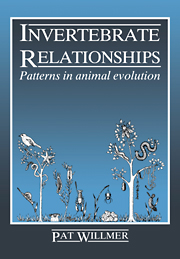Book contents
- Frontmatter
- Contents
- Acknowledgements
- Part I Introduction to animal phylogeny
- Part II Sources of evidence in invertebrate phylogeny
- Part III Phylogeny of major groups
- 7 The origin of the Metazoa
- 8 Acoelomates and other lowly worms
- 9 The pseudocoelomates
- 10 The phylogenetic position of molluscs
- 11 Arthropod phylogeny
- 12 The deuterostomes
- 13 The lophophorates
- 14 A phylogenetic overview of invertebrates
- References
- Index
10 - The phylogenetic position of molluscs
Published online by Cambridge University Press: 08 January 2010
- Frontmatter
- Contents
- Acknowledgements
- Part I Introduction to animal phylogeny
- Part II Sources of evidence in invertebrate phylogeny
- Part III Phylogeny of major groups
- 7 The origin of the Metazoa
- 8 Acoelomates and other lowly worms
- 9 The pseudocoelomates
- 10 The phylogenetic position of molluscs
- 11 Arthropod phylogeny
- 12 The deuterostomes
- 13 The lophophorates
- 14 A phylogenetic overview of invertebrates
- References
- Index
Summary
Introduction
The phylum Mollusca is structurally and ecologically enormously diverse, and highly speciose. Inevitably this makes the search for ancestral forms and possible origins more difficult, and there have been endless controversies over the nature of the molluscan ‘archetype’, and over relations between the various sub-phyla or classes that it gave rise to. However, there is perhaps a stronger current consensus over the status of the molluscs, and their position relative to other phyla, than there has been for many decades; consequently this chapter presents reasonably uncontroversial material, with which most modern treatments would concur.
Nevertheless many text-books and the simplified phylogenetic trees commonly presented therein still treat the molluscs in a rather outdated manner and insist on their close affinities to annelids and arthropods, endowing them with coeloms (and sometimes even segmentation) of a homologous if reduced nature. Such traditional views usually combine these three groups as the major spiralian or protostome invertebrates, at the apex of the left-hand ‘branch’ of a neatly dichotomous ‘tree’. It is therefore necessary to consider the evidence that gave them this position for the best part of a century, before turning to the insights from morphology and embryology that have, within the last two decades, led to their relocation as derivatives of a turbellarian-like form (a view actually initiated in the 1890s).
The traditional ‘annelid theory’ for the origins of molluscs is fast losing ground to the newer views, but there remains some dispute over the relative affinities of the annelids, molluscs and flatworms.
- Type
- Chapter
- Information
- Invertebrate RelationshipsPatterns in Animal Evolution, pp. 249 - 270Publisher: Cambridge University PressPrint publication year: 1990



